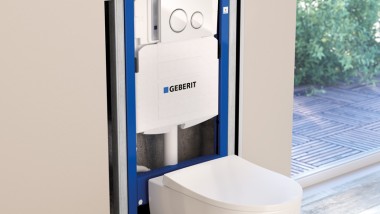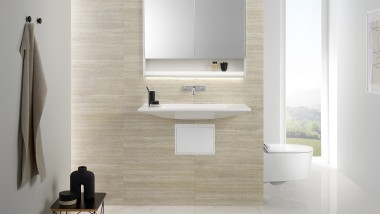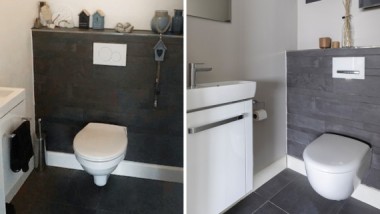How small can a washbasin be?
It is no coincidence that the projection, i.e. the depth of a floor-standing washbasin, has levelled off at around 19“ (48 cm) over time. Not only the ceramic appliance, but also the matching furniture units and even the faucets are normally precut to this dimension.
Just like with many other things that we use on daily basis, these elements have been standardized as a result of industrialization. In the past, washbasins were considerably larger, but there has been a trend towards minimization. Of course, apartments and their bathrooms and guest bathrooms have also become smaller over time. But this minimalist trend has not stopped at 19“: Nowadays, there are a large number of mini washbasins with a projection of 14.5“ or even 10“, specifically designed for small guest bathrooms.
Dutch preferences
What’s considered acceptable is entirely in the eye of the beholder – and a look at the Netherlands shows that their preferences can be quite surprising. This is a nation that is virtually obsessed with small formats, something that is not immediately understandable given the average height of the Dutch population. In fact, there are no concrete “physical” reasons behind this preference, which actually stems from an architectural tradition.
A question of harmony
Tradition or not – which factors do you need to consider if you want to equip your guest bathroom with a small but flawless washbasin solution?
- When it comes to the washbasin design, it should be as large as possible if you are very limited with space. You will often find asymmetrical designs in the segment in question, with the faucet positioned on the side. This ensures that you can make maximum use of the washbasin, and there is some space left over for a shelf surface.
- Naturally, the washbasin should also be deep enough so that you can hold both hands under the water. A “dry run” in a showroom can easily help you find the perfect depth.
- The faucet size: While in the showroom, you should also take a closer look at both the washbasin and faucet and, in particular, where the water jet hits the ceramic. Faucet manufacturers often offer smaller faucets in product ranges designed specifically for guest bathrooms. Even a small washbasin can be very appealing when equipped with a matching faucet.
4. Special corner solutions enable the use of small washbasins in guest bathrooms with challenging floor plans. Look for a washbasin with an atypical, corner-mounted shape, something not very many people realize is even available!
5. The shape of the washbasin: a small washbasin always means a loss of space because there is less shelf surface on the ceramic fixture. Depending on the shape of the washbasin, however, it is possible to gain maximum space. If you choose an asymmetrical washbasin shape, with the faucet attached at the side, there is still enough space on the sink for everyday bathroom items.
6. Functionality is important. Even with small handwash basins, there has to be enough space to hold your hands completely under water. This is why it is important not to underestimate the importance of the depth of the washbasin. You can easily test this in a dry run in a showroom.
7. You can also save space with faucets, for example with wall-hung models. It is always a good idea to look at the faucets at the same time as the basin. If you check the water jet’s line of fire, you can prevent water splashes. Faucet manufacturers often provide shorter models which are designed to be used in small bathrooms.
In a narrow bathroom or a small guest bathroom, a handrinse basin should not take up too much space yet still be practical and attractive. So how do you go about it? These tips will help you:
1. A standard size washbasin has a projection (depth) of around 22“ (55 cm). A handrinse basin normally has a depth of 18“ (45 cm). But in narrow or small bathrooms, there is often not that much space. This is where narrower washbasins come into play. There are now a number of mini washbasins with a projection of 8“ to 10“ (20 to 25 cm).
2. The interaction between ceramic appliances and furniture makes a real difference in the bathroom. When it comes to small rooms, it is useful to look at the washbasin in combination with the other furnishings. With the help of a professional designer, you can design your own bathroom true to size and detail. First draw the exact floor plan and then position the washbasin, furniture, and other items. A 3D model can show you which space-saving solution is best for the room.
3. Clever design: Washbasins are not only available in different sizes, but also in a whole range of different, timeless designs. Whether angular, oval, or round, with a vertical or horizontal drain: different variants make sense depending on the room. In confined spaces, the small handrinse basins with a space-saving washbasin drain are practical. They are designed so that they can be combined with a narrow washbasin cabinet or a washtop, resulting in as much storage space as possible.
4. Special corner solutions make the use of small washbasins in guest bathrooms with challenging floor plans possible.
5. The shape of the washbasin: a small washbasin always means a loss of space because there is less shelf surface on the ceramic appliance. Depending on the shape of the washbasin, however, it is possible to gain maximum space. If you choose an asymmetrical washbasin shape, with the faucet attached at the side, there is still enough space on the ceramic appliance for everyday bathroom items.
6. Functionality is important. Even with small handrinse basins, there has to be enough space to hold your hands completely under water. This is why it is important not to underestimate the importance of the depth of the washbasin. You can easily test this in a dry run in a showroom.
7. You can also save space with faucets, for example with wall-hung options. It is always a good idea to look at the faucets in conjunction with the handrinse basin. If you check the water jet’s line of fire, you can prevent water splashes. Faucet manufacturers often provide shorter models which are designed to be used in small bathrooms.


